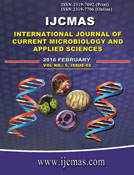


 National Academy of Agricultural Sciences (NAAS)
National Academy of Agricultural Sciences (NAAS)

|
PRINT ISSN : 2319-7692
Online ISSN : 2319-7706 Issues : 12 per year Publisher : Excellent Publishers Email : editorijcmas@gmail.com / submit@ijcmas.com Editor-in-chief: Dr.M.Prakash Index Copernicus ICV 2018: 95.39 NAAS RATING 2020: 5.38 |
This study was conducted in Ambedkar Nagar district from August 2012 to January 2016 to see the prevalence of various bacteria causing Urinary Tract Infections in patients with burning micturition, kidney or ureteric stones, pregnant women and catheterised patients. The antibiotic susceptibility pattern of these isolates was studied.The maximum patient group presented with burning micturition (63%) followed by kidney stones (16.5%) and pregnant women (10.4%). Of a total number of 1078 urine samples Escherichia coli showed maximum growth (49.5%) followed by Klebsiella pneumoniae (24.7%), Pseudomonas aeruginosa (9.5%), Proteus mirabilis (5.1%), Citrobacter freundii (2.5%), Enterobacter (1.9%), Staphylococcus aureus (2.1%), Staphylococcus epidermidis (1.3%) and Enterococcus spp.(1.02%).Most of the isolates showed susceptibility to Amikacin followed by Nitrofurantoin. The isolates were found resistant to Amoxiclav and Co-trimoxazole. The increasing trend of resistant strains depicts the misuse and indiscriminate use of antibiotics and warrants attention. This is the first study from this area where patients with high incidence of kidney stones have been reported.
 |
 |
 |
 |
 |